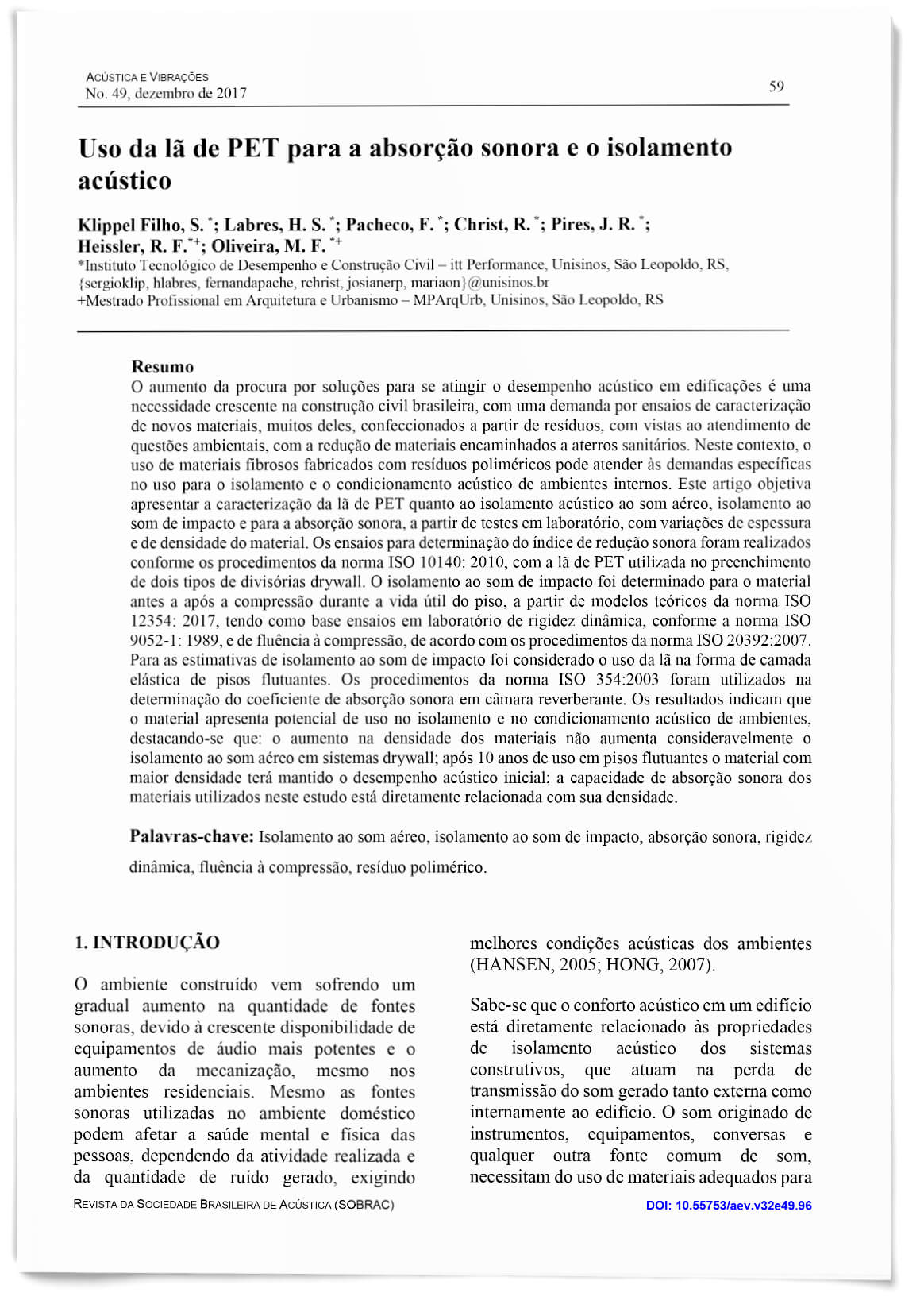Uso da lã de PET para a absorção sonora e o isolamento acústico
DOI:
https://doi.org/10.55753/aev.v32e49.96Palavras-chave:
isolamento ao som aéreo, isolamento ao som de impacto, absorção sonora, rigidez dinâmica, fluência à compressão, resíduo poliméricoResumo
O aumento da procura por soluções para se atingir o desempenho acústico em edificações é uma necessidade crescente na construção civil brasileira, com uma demanda por ensaios de caracterização de novos materiais, muitos deles, confeccionados a partir de resíduos, com vistas ao atendimento de questões ambientais, com a redução de materiais encaminhados a aterros sanitários. Neste contexto, o uso de materiais fibrosos fabricados com resíduos poliméricos pode atender às demandas específicas no uso para o isolamento e o condicionamento acústico de ambientes internos. Este artigo objetiva apresentar a caracterização da lã de PET quanto ao isolamento acústico ao som aéreo, isolamento ao som de impacto e para a absorção sonora, a partir de testes em laboratório, com variações de espessura e de densidade do material. Os ensaios para determinação do índice de redução sonora foram realizados conforme os procedimentos da norma ISO 10140: 2010, com a lã de PET utilizada no preenchimento de dois tipos de divisórias drywall. O isolamento ao som de impacto foi determinado para o material antes a após a compressão durante a vida útil do piso, a partir de modelos teóricos da norma ISO 12354: 2017, tendo como base ensaios em laboratório de rigidez dinâmica, conforme a norma ISO 9052-1: 1989, e de fluência à compressão, de acordo com os procedimentos da norma ISO 20392:2007. Para as estimativas de isolamento ao som de impacto foi considerado o uso da lã na forma de camada elástica de pisos flutuantes. Os procedimentos da norma ISO 354:2003 foram utilizados na determinação do coeficiente de absorção sonora em câmara reverberante. Os resultados indicam que o material apresenta potencial de uso no isolamento e no condicionamento acústico de ambientes, destacando-se que: o aumento na densidade dos materiais não aumenta consideravelmente o isolamento ao som aéreo em sistemas drywall; após 10 anos de uso em pisos flutuantes o material com maior densidade terá mantido o desempenho acústico inicial; a capacidade de absorção sonora dos materiais utilizados neste estudo está diretamente relacionada com sua densidade.
Referências
ARENAS, J. P.; CROCKER, M. J. Recent trends in porous sound-absorbing materials. Sound and vibration, 2010. v. 44, p. 12–17.
ASDRUBALI, F.; SCHIAVONI, S.; HOROSHENKOV. A review of sustainable materials for acoustic applications. Building Acoustics, 2012. v. 19, n. 4, p. 283-311. doi: 10.1260%2F1351-010X.19.4.283 DOI: https://doi.org/10.1260/1351-010X.19.4.283
BRANDÃO, E. Acústica de salas. São Paulo: Edgard Blucher, 2016.
CRIPPS, A; FOVARGUE, J. Crops in Construction Handbook. London: CIRIA, 2004. 112 p.
EGAN, D. Architectural Acoustics. New York: McGraw-Hill, 2014.
GUILLEN, I. et al. On the sound insulation of masonry wall façades. Building and environment, 2008. v. 43, n. 4, p. 523–529. DOI: https://doi.org/10.1016/j.buildenv.2007.01.010
HANSEN, C. Noise control - from concept to application. London: Taylor & Francis, 2005. doi: 10.1201/9781315274911 DOI: https://doi.org/10.1201/9781315274911
HONG, Z. et al. A novel composite sound absorber with recycled rubber particles. Journal of sound and vibration, 2007. v. 304, n. 1–2, p. 400–406. doi: 10.1016/j.jsv.2007.02.024 DOI: https://doi.org/10.1016/j.jsv.2007.02.024
HUANG, C.-H. et al. The efficacy of coconut fibers on the sound-absorbing and termal insulating nonwoven composite board. Fibers and polymers, 2013. v. 14, n. 8, p. 1378–1385. doi: 10.1007/s12221-013-1378-7 DOI: https://doi.org/10.1007/s12221-013-1378-7
INTERNATIONAL ORGANIZATION FOR STANDARDIZATION. ISO 12354 – Building acoustics: Estimation of acoustic performance of buildings from the performance elements – Part 2: Impact sound insulation between rooms. 2017.
______. ISO 10140 - Acoustics: laboratory measurement of sound insulation of buildings elements - Part 5: Requirements for test facilities and equipment. 2010a.
______. ISO 10140 - Acoustics: laboratory measurement of sound insulation of buildings elements - Part 2: Measurement of airborne sound insulation. 2010b.
______. ISO 10140 - Acoustics: laboratory measurement of sound insulation of buildings elements - Part 4: Measurement procedures and requirements. 2010c.
______. ISO 11654 - Acoustics: Sound absorbers for use in buildings – Rating of sound absorption.1997.
______. ISO 20392 – Thermal-insulating materials: Determination of compressive creep. 2007.
______. ISO 3382 - Acoustics: Measurement of room acoustic parameters - Part 2: Reverberation time in ordinary rooms. 2008.
______. ISO 354 - Acoustics: Measurement of sound absorption in a reverberant room. 2003.
______. ISO 717 - Acoustics: Rating of sound insulation in buildings and of building elements - Part 1: Airborne sound insulation. 2013.
______. ISO 9052 - Acoustics: Determination of dynamic stiffness – Part 1: Materials used under floating floors in dwellings.1989.
LOU, C. W.; CHEN, P.; LIN, J. H. Manufacturing process and property analysis of sound absorption sandwich board. Advanced materials research, 2008. v. 55–57, p. 393–396. DOI: https://doi.org/10.4028/www.scientific.net/AMR.55-57.393
MACDONALD, W. A. New advances in poly(ethylene terephthalate) polymerization and degradation. Polymer international, 2002. v. 51, n. 10, p. 923–930. doi: 10.1002/pi.917 DOI: https://doi.org/10.1002/pi.917
MAEKAWA, Z.; RINDEL, J. H.; LORD, P. Environmental and architectural acoustics. 2. ed. New York: Spon Press, 2011. doi: 10.4324/9780203931356 DOI: https://doi.org/10.4324/9780203931356
PACHECO, E. B.; HEMAIS, C. A. Mercado para produtos reciclados à base de
pet/hdpe/ionômero. Polímeros: ciência e tecnologia, 1999. p. 59–64. doi: 10.1590/S0104-14281999000400010 DOI: https://doi.org/10.1590/S0104-14281999000400010
REY, R. DEL et al. Nuevos materiales absorbentes acústicos obtenidos a partir de restos de botellas de plástico. Materiales de Construcción, 2011. v. 61, n. 304, p. 547–558. doi: 10.3989/MC.2011.59610 DOI: https://doi.org/10.3989/mc.2011.59610
SIMÕES, M. F.; OLIVEIRA, B. D.; BECKER, R. R. Isolamento e condicionamento acústico do Auditório Araújo Vianna em Porto Alegre, RS. In: ENCONTRO SOBRAC, XXV, p. 336- 343, 2014.
TUTIKIAN, B. F.; ZUCHETTO, L. K.; SOUZA, R. P.; OLIVEIRA, M. F. Uso de agregado leve de EVA em contrapiso argamassado para isolamento ao ruído de impacto em edificações residenciais. Ambiente Construído, 2017. v. 17, n. 3, p. 295–306. doi: 10.1590/s1678-86212017000300177 DOI: https://doi.org/10.1590/s1678-86212017000300177
UYCIEC – UNIVERSITY OF YORK CENTRE FOR INDUSTRY EDUCATION COLLABORATION. Polyesters (on line version). UK. Last update in 25th August 2016.
ZUCHETTO, L. K.; NUNES, M. F. O.; PATRÍCIO, J. V. Influence of the compression conditions in the acoustic performance of resilient layers of floors. In: 22nd International Congress on Acoustics – ICA 2016. Buenos Aires: Asociación de Acústicos Argentinos, 2016.

Downloads
Publicado
Como Citar
Edição
Seção
Licença
Copyright (c) 2017 Acústica e Vibrações

Este trabalho está licenciado sob uma licença Creative Commons Attribution-NonCommercial-ShareAlike 4.0 International License.




